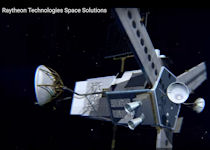Next-Gen OPIR / Next Generation Overhead Persistent Infrared Polar
 The Air Force announced 04 May 2018 its intention to award two sole-source contracts for the Next-Generation Overhead Persistent Infrared program. The first contract will be sole-sourced to Lockheed Martin Space to define requirements, create the initial design and identify and procure flight hardware for a satellite to operate in geosynchronous orbit. The second contract will be sole-sourced to Northrop Grumman Aerospace Systems to define polar system requirements.
The Air Force announced 04 May 2018 its intention to award two sole-source contracts for the Next-Generation Overhead Persistent Infrared program. The first contract will be sole-sourced to Lockheed Martin Space to define requirements, create the initial design and identify and procure flight hardware for a satellite to operate in geosynchronous orbit. The second contract will be sole-sourced to Northrop Grumman Aerospace Systems to define polar system requirements.
"As we develop these new systems, speed matters," said Secretary of the Air Force Heather Wilson. "The next generation missile warning satellite will be a pace-setter." Next-Gen OPIR will succeed the current Space Based Infrared System by providing improved missile warning capabilities that are more survivable against emerging threats.
"The next generation missile warning will be an important pace-setter for learning to speed up traditional acquisitions. This is more than just building a prototype or a low-cost system," said Dr. Will Roper, Assistant Secretary of the Air Force for Acquisition, Technology and Logistics. "This is an important system for the nation, and to 'go for the gold' by targeting five years instead of nine years allows us to pick up the pace to defend the nation." The Air Force is the lead agency for procuring Next-Gen OPIR satellites. The Space and Missile Systems Center's Remote Sensing Systems Directorate at Los Angeles Air Force Base, California is the acquisition program office.
Space Based Infrared Systems (SBIRS) provides initial warning of a ballistic missile attack on the U.S., its deployed forces, or its allies. SBIRS also supports missile defense, technical intelligence, and battlespace awareness missions. The architecture consists of satellites in Geosynchronous Earth Orbit (GEO) and Highly Elliptical Orbit (HEO), ground segment, relay ground stations, and a mobile ground system. Next-Generation Overhead Persistent Infrared (Next-Gen OPIR) is the successor to SBIRS.
The Department of the Air Force, Space and Missile Systems Center, Remote Sensing Systems Directorate (SMC/RS) announced 04 May 2018 that it intended to execute a sole source contract with Northrop Grumman to acquire the Next Generation Overhead Persistent Infrared (Next Gen OPIR) Polar Orbit Space Vehicles 1&2. The anticipated contract will be predominantly Cost Plus Incentive Fee (CPIF). This action will be executed via an Undefinitized Contract Action (UCA) for requirements analysis and risk reduction efforts; a subsequent contract modification for design/development, critical path flight hardware, and risk reduction efforts; and another contract modification for the manufacturing, assembly, integration, test and delivery of Space Vehicles 1&2.
This action is made pursuant to 10 U.S.C. 2304(c)(3), as implemented by FAR 6.302-3(a)(2)(i). Based on market research, full and open competition need not be provided for the Next Gen OPIR Polar requirements, and those requirements must be awarded to Northrop Grumman in order to develop and maintain a second provider of strategically survivable/endurable spacecraft to achieve industrial mobilization.
Northrop Grumman Systems Corp., Redondo Beach, California, was awarded on May 18, 2020 a not-to-exceed $2,375,000,000 undefinitized contract modification (P00013) to contract FA8810-18-C-0006 for Next Generation Overhead Persistent Infrared Polar Space Vehicles 1 and 2. This modification adds Phase One for design/development, critical path flight hardware procurement, and risk reduction efforts leading to a critical design review to the basic contract. Work will be performed in Redondo Beach, California, and is expected to be completed by December 2025. Fiscal 2020 research, development, test and evaluation funds in the amount of $70,500,000 are being obligated at the time of award. Total cumulative face value of the contract is $2,419,295,532. Space and Missile Systems Center, Los Angeles Air Force Base, California, is the contracting activity.

